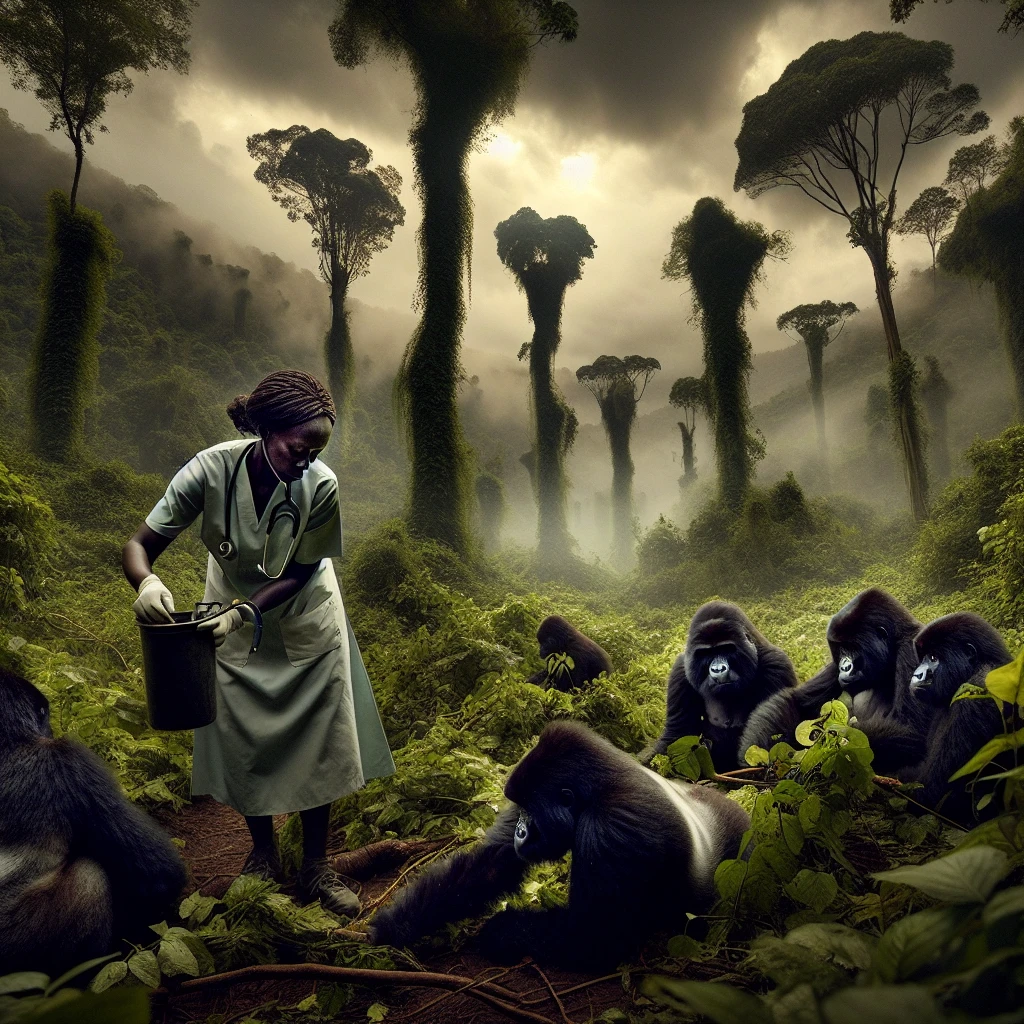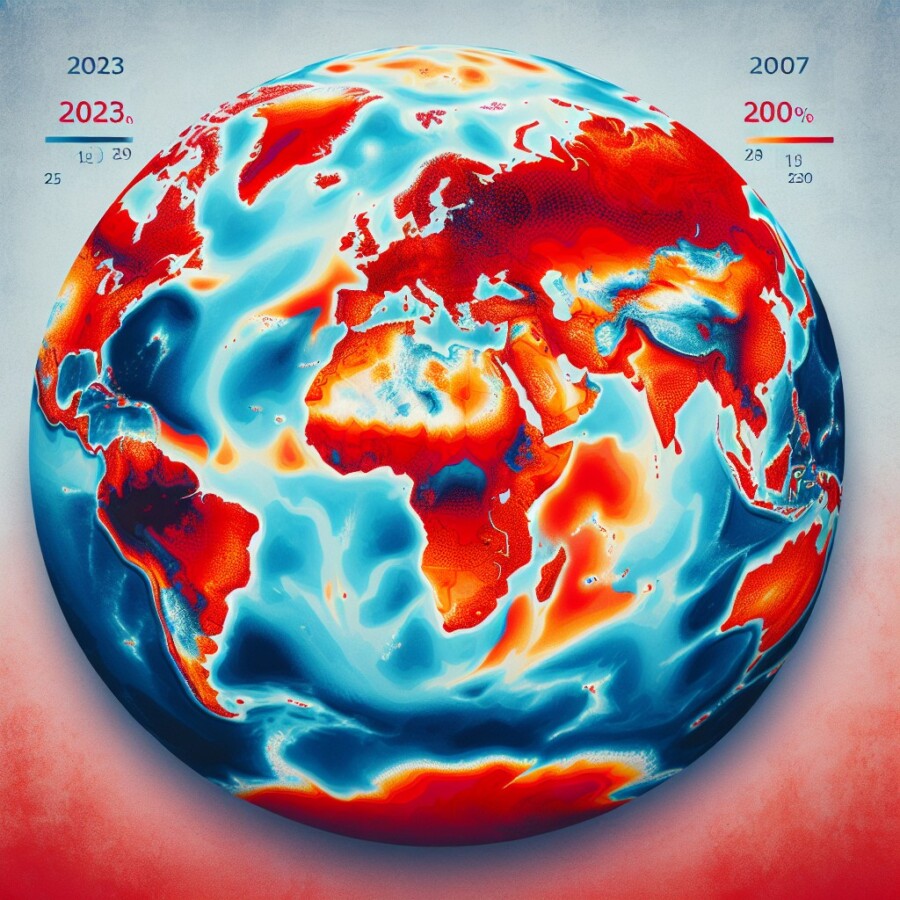Uganda’s mountain gorillas are facing a threat to their health due to the effects of climate change. Gladys Kalema-Zikusoka, the country’s first wildlife vet and founder of Conservation Through Public Health, is working tirelessly to save these endangered animals. Her organization aims to promote biodiversity conservation by fostering coexistence between humans, gorillas, and other wildlife while improving their overall health.
Dr. Kalema-Zikusoka’s efforts have been successful in increasing the population of mountain gorillas from 300 to approximately 500. This achievement has led to their reclassification from critically endangered to endangered. Her work spans over three decades of fieldwork and has made a significant impact on the conservation of these magnificent creatures.
Recognizing her remarkable contributions, Dr. Kalema-Zikusoka has been included in the BBC 100 Women list this year. This list showcases women who are making a difference in various fields, including wildlife conservation in the face of climate change. To learn more about her and other women working towards this cause, you can read the full story on the BBC website.
To stay updated on the work of Dr. Kalema-Zikusoka and other inspiring women, you can follow BBC 100 Women on Facebook and Instagram. Join the conversation using the hashtag #BBC100Women. The video accompanying this article, produced and edited by Rebecca Thorn and filmed by Godfrey Badebye, provides further insight into the efforts to save Uganda’s gorillas from the impacts of climate change.
In conclusion, the work of Dr. Gladys Kalema-Zikusoka and her organization Conservation Through Public Health is crucial in safeguarding Uganda’s mountain gorillas from the threats posed by climate change. Through her dedication and expertise, she has been able to increase their population and improve their conservation status. Her inclusion in the BBC 100 Women list is a testament to her significant contributions to wildlife conservation.
Original news source: Climate change: Saving Uganda’s mountain gorillas (BBC)
Listen
Slow
Normal
Fast
Group or Classroom Activities
Warm-up Activities:
– News Summary
Instructions:
1. Divide the class into pairs or small groups.
2. Give each group a copy of the article.
3. Instruct the students to read the article and summarize the main points in a few sentences.
4. After they have finished, have each group share their summaries with the class.
– Opinion Poll
Instructions:
1. Divide the class into pairs or small groups.
2. Ask the students to read the article and form an opinion on the importance of Dr. Kalema-Zikusoka’s work.
3. Provide them with a list of statements related to the article, such as “Dr. Kalema-Zikusoka’s efforts are essential for the survival of mountain gorillas.”
4. Instruct the students to discuss their opinions and vote whether they agree or disagree with each statement.
5. After the discussion, have each group share their opinions and reasoning with the class.
– Keyword Hangman
Instructions:
1. Write the title of the article, “Uganda’s mountain gorillas face threat from climate change,” on the board, leaving out some of the keywords.
2. Divide the class into two teams.
3. One student from each team will come up to the board, take turns guessing letters to complete the missing keywords.
4. If a team guesses a correct letter, write it in the appropriate position. If they guess incorrectly, draw a part of the hangman.
5. The first team to correctly guess all the missing keywords wins.
– Pros and Cons
Instructions:
1. Divide the class into pairs or small groups.
2. Assign each group the task of discussing the pros and cons of Dr. Kalema-Zikusoka’s work.
3. Instruct them to list the positive and negative aspects of her efforts in a T-chart or similar format.
4. After the discussion, have each group share their lists with the class and facilitate a class discussion on the topic.
– Future Predictions
Instructions:
1. Instruct the students to imagine they are environmentalists in the year 2050.
2. Ask them to write a short paragraph predicting the state of Uganda’s mountain gorillas and their conservation efforts.
3. Encourage them to consider the potential effects of climate change and other factors on the population and conservation efforts.
4. After they have finished writing, have a few volunteers share their predictions with the class.
Comprehension Questions:
1. What is the main focus of Dr. Gladys Kalema-Zikusoka’s organization, Conservation Through Public Health?
2. How has Dr. Kalema-Zikusoka’s work impacted the population of mountain gorillas in Uganda?
3. Why were mountain gorillas reclassified from critically endangered to endangered?
4. What recognition has Dr. Kalema-Zikusoka received for her contributions to wildlife conservation?
5. What is the purpose of the BBC 100 Women list?
6. How can people stay updated on the work of Dr. Kalema-Zikusoka and other inspiring women?
7. What does the video accompanying the article provide insight into?
8. Why is Dr. Kalema-Zikusoka’s work crucial in safeguarding Uganda’s mountain gorillas?
Go to answers ⇩
Listen and Fill in the Gaps:
Uganda’s mountain gorillas are facing a threat to their health due to the effects of (1)______ change. Gladys Kalema-Zikusoka, the country’s first wildlife vet and founder of Conservation Through Public Health, is working tirelessly to save these endangered animals. Her organization aims to promote biodiversity conservation by fostering (2)______ between (3)______, gorillas, and other wildlife while (4)______ their overall health.
Dr. Kalema-Zikusoka’s efforts have been successful in increasing the population of mountain gorillas from 300 to approximately 500. This achievement has led to their reclassification from critically (5)______ to endangered. Her work spans over three decades of fieldwork and has made a (6)______ impact on the conservation of these magnificent (7)______.
Recognizing her remarkable (8)______, Dr. Kalema-Zikusoka has been included in the BBC 100 Women list this year. This list showcases women who are making a difference in various fields, including wildlife conservation in the face of climate change. To learn more about her and other women working towards this cause, you can read the full story on the BBC website.
To stay (9)______ on the work of Dr. Kalema-Zikusoka and other inspiring women, you can follow BBC 100 Women on Facebook and Instagram. Join the conversation using the (10)______ #BBC100Women. The video accompanying this article, produced and edited by (11)______ Thorn and filmed by Godfrey Badebye, (12)______ further insight into the efforts to save Uganda’s gorillas from the impacts of climate change.
In conclusion, the work of Dr. Gladys Kalema-Zikusoka and her organization Conservation Through Public Health is crucial in safeguarding Uganda’s mountain gorillas from the threats posed by climate change. Through her dedication and (13)______, she has been able to increase their population and improve their conservation (14)______. Her inclusion in the BBC 100 Women list is a (15)______ to her significant contributions to (16)______ conservation.
Go to answers ⇩
Discussion Questions:
Students can ask a partner these questions, or discuss them as a group.
1. What do you think are the biggest threats to wildlife conservation today?
2. How do you feel about the efforts of Dr. Gladys Kalema-Zikusoka to save Uganda’s mountain gorillas?
3. Do you think it is important for humans and wildlife to coexist? Why or why not?
4. Have you ever witnessed the effects of climate change in your own country? How did it make you feel?
5. What do you think can be done to raise awareness about the importance of biodiversity conservation?
6. How would you feel if you were able to make a significant impact on the conservation of an endangered species?
7. Do you think it is the responsibility of individuals or governments to take action against climate change? Why or why not?
8. What is your opinion on including more women in the field of wildlife conservation?
9. Have you ever visited a wildlife conservation organization or participated in any conservation activities? If so, what was your experience like?
10. How do you think climate change affects the overall health of animals?
11. Do you think the reclassification of the mountain gorillas from critically endangered to endangered is a significant achievement? Why or why not?
12. What is your opinion on using social media platforms to raise awareness about wildlife conservation?
13. How would you feel if you were recognized for your contributions to a cause you are passionate about?
14. Do you think it is possible to completely reverse the effects of climate change on wildlife populations? Why or why not?
15. What actions can individuals take in their daily lives to help mitigate the effects of climate change on wildlife?
Individual Activities
Vocabulary Meanings:
Match each word to its meaning.
Words:
1. Uganda’s
2. mountain
3. gorillas
4. climate
5. change
6. wildlife
7. conservation
8. health
Meanings:
(a) The long-term weather patterns of a region
(b) The protection and preservation of animals and plants
(c) The country where the gorillas are located
(d) The alteration of the Earth’s climate system
(e) The overall well-being and condition of the animals
(f) Endangered animals that are being protected
(g) A type of terrain where the gorillas live
(h) The protection and preservation of natural habitats
Go to answers ⇩
Multiple Choice Questions:
1. What is the main focus of Conservation Through Public Health?
(a) Increasing the population of mountain gorillas
(b) Reducing the effects of climate change
(c) Promoting coexistence between humans, gorillas, and other wildlife
(d) Improving overall health of wildlife
2. How has Dr. Gladys Kalema-Zikusoka’s work impacted the population of mountain gorillas?
(a) Decreased the population from 500 to approximately 300
(b) Maintained a stable population of 300 mountain gorillas
(c) No impact on the population of mountain gorillas
(d) Increased the population from 300 to approximately 500
3. Why were mountain gorillas reclassified from critically endangered to endangered?
(a) Due to a decrease in their population
(b) Due to an increase in their population
(c) Due to the successful efforts of Dr. Kalema-Zikusoka
(d) Due to changes in their habitat
4. What recognition has Dr. Gladys Kalema-Zikusoka received for her work?
(a) Nobel Peace Prize
(b) Time Magazine’s Person of the Year
(c) None of the above
(d) Inclusion in the BBC 100 Women list
5. What is the purpose of the BBC 100 Women list?
(a) To showcase women making a difference in various fields
(b) To promote wildlife conservation in Uganda
(c) To raise awareness about the impacts of climate change
(d) To highlight the work of Dr. Gladys Kalema-Zikusoka
6. How long has Dr. Gladys Kalema-Zikusoka been working in the field of wildlife conservation?
(a) Less than a year
(b) Over three decades
(c) Five years
(d) Ten years
7. What is the main threat to the health of Uganda’s mountain gorillas?
(a) Poaching
(b) Climate change
(c) Habitat loss
(d) Disease
8. How can people stay updated on the work of Dr. Gladys Kalema-Zikusoka and other inspiring women?
(a) Follow BBC 100 Women on Facebook and Instagram
(b) Read the full story on the BBC website
(c) Watch the accompanying video
(d) All of the above
Go to answers ⇩
True or False Questions:
1. Dr. Kalema-Zikusoka has not been included in the BBC 100 Women list for her remarkable contributions to wildlife conservation.
2. The BBC 100 Women list does not showcase women making a difference in various fields, including wildlife conservation in the face of climate change.
3. Uganda’s mountain gorillas are facing a threat to their health due to climate change.
4. Dr. Kalema-Zikusoka’s efforts have successfully increased the population of mountain gorillas from 300 to approximately 500.
5. Dr. Gladys Kalema-Zikusoka is not the country’s first wildlife vet and founder of Conservation Through Public Health.
6. Conservation Through Public Health does not aim to promote coexistence between humans, gorillas, and other wildlife while improving their overall health.
7. The population increase has led to the reclassification of mountain gorillas from critically endangered to endangered.
8. The video accompanying the article provides further insight into the efforts to save Uganda’s gorillas from the impacts of climate change.
Go to answers ⇩
Write a Summary:
Write a summary of this news article in two sentences.
Check your writing now with the best free AI for English writing!
Writing Questions:
Answer the following questions. Write as much as you can for each answer.
Check your answers with our free English writing assistant!
1. What is the main goal of Conservation Through Public Health?
2. How has Dr. Gladys Kalema-Zikusoka’s work impacted the population of mountain gorillas?
3. Why have mountain gorillas been reclassified from critically endangered to endangered?
4. What recognition has Dr. Kalema-Zikusoka received for her contributions to wildlife conservation?
5. How can people stay updated on the work of Dr. Kalema-Zikusoka and other inspiring women in wildlife conservation?
Answers
Comprehension Question Answers:
1. The main focus of Dr. Gladys Kalema-Zikusoka’s organization, Conservation Through Public Health, is to promote biodiversity conservation by fostering coexistence between humans, gorillas, and other wildlife while improving their overall health.
2. Dr. Kalema-Zikusoka’s work has impacted the population of mountain gorillas in Uganda by increasing their numbers from 300 to approximately 500.
3. Mountain gorillas were reclassified from critically endangered to endangered due to the successful conservation efforts led by Dr. Kalema-Zikusoka, which resulted in an increase in their population.
4. Dr. Kalema-Zikusoka has been recognized for her contributions to wildlife conservation by being included in the BBC 100 Women list.
5. The purpose of the BBC 100 Women list is to showcase women who are making a difference in various fields, including wildlife conservation in the face of climate change.
6. People can stay updated on the work of Dr. Kalema-Zikusoka and other inspiring women by following BBC 100 Women on Facebook and Instagram.
7. The video accompanying the article provides insight into the efforts to save Uganda’s gorillas from the impacts of climate change.
8. Dr. Kalema-Zikusoka’s work is crucial in safeguarding Uganda’s mountain gorillas because she has been able to increase their population and improve their conservation status through her dedication and expertise.
Go back to questions ⇧
Listen and Fill in the Gaps Answers:
(1) climate
(2) coexistence
(3) humans
(4) improving
(5) endangered
(6) significant
(7) creatures
(8) contributions
(9) updated
(10) hashtag
(11) Rebecca
(12) provides
(13) expertise
(14) status
(15) testament
(16) wildlife
Go back to questions ⇧
Vocabulary Meanings Answers:
1. Uganda’s
Answer: (c) The country where the gorillas are located
2. mountain
Answer: (g) A type of terrain where the gorillas live
3. gorillas
Answer: (f) Endangered animals that are being protected
4. climate
Answer: (a) The long-term weather patterns of a region
5. change
Answer: (d) The alteration of the Earth’s climate system
6. wildlife
Answer: (b) The protection and preservation of animals and plants
7. conservation
Answer: (e) The overall well-being and condition of the animals
8. health
Answer: (h) The protection and preservation of natural habitats
Go back to questions ⇧
Multiple Choice Answers:
1. What is the main focus of Conservation Through Public Health?
Answer: (c) Promoting coexistence between humans, gorillas, and other wildlife
2. How has Dr. Gladys Kalema-Zikusoka’s work impacted the population of mountain gorillas?
Answer: (d) Increased the population from 300 to approximately 500
3. Why were mountain gorillas reclassified from critically endangered to endangered?
Answer: (c) Due to the successful efforts of Dr. Kalema-Zikusoka
4. What recognition has Dr. Gladys Kalema-Zikusoka received for her work?
Answer: (d) Inclusion in the BBC 100 Women list
5. What is the purpose of the BBC 100 Women list?
Answer: (a) To showcase women making a difference in various fields
6. How long has Dr. Gladys Kalema-Zikusoka been working in the field of wildlife conservation?
Answer: (b) Over three decades
7. What is the main threat to the health of Uganda’s mountain gorillas?
Answer: (b) Climate change
8. How can people stay updated on the work of Dr. Gladys Kalema-Zikusoka and other inspiring women?
Answer: (a) Follow BBC 100 Women on Facebook and Instagram
Go back to questions ⇧
True or False Answers:
1. Dr. Kalema-Zikusoka has not been included in the BBC 100 Women list for her remarkable contributions to wildlife conservation. (Answer: False)
2. The BBC 100 Women list does not showcase women making a difference in various fields, including wildlife conservation in the face of climate change. (Answer: False)
3. Uganda’s mountain gorillas are facing a threat to their health due to climate change. (Answer: True)
4. Dr. Kalema-Zikusoka’s efforts have successfully increased the population of mountain gorillas from 300 to approximately 500. (Answer: True)
5. Dr. Gladys Kalema-Zikusoka is not the country’s first wildlife vet and founder of Conservation Through Public Health. (Answer: False)
6. Conservation Through Public Health does not aim to promote coexistence between humans, gorillas, and other wildlife while improving their overall health. (Answer: False)
7. The population increase has led to the reclassification of mountain gorillas from critically endangered to endangered. (Answer: True)
8. The video accompanying the article provides further insight into the efforts to save Uganda’s gorillas from the impacts of climate change. (Answer: True)
Go back to questions ⇧













